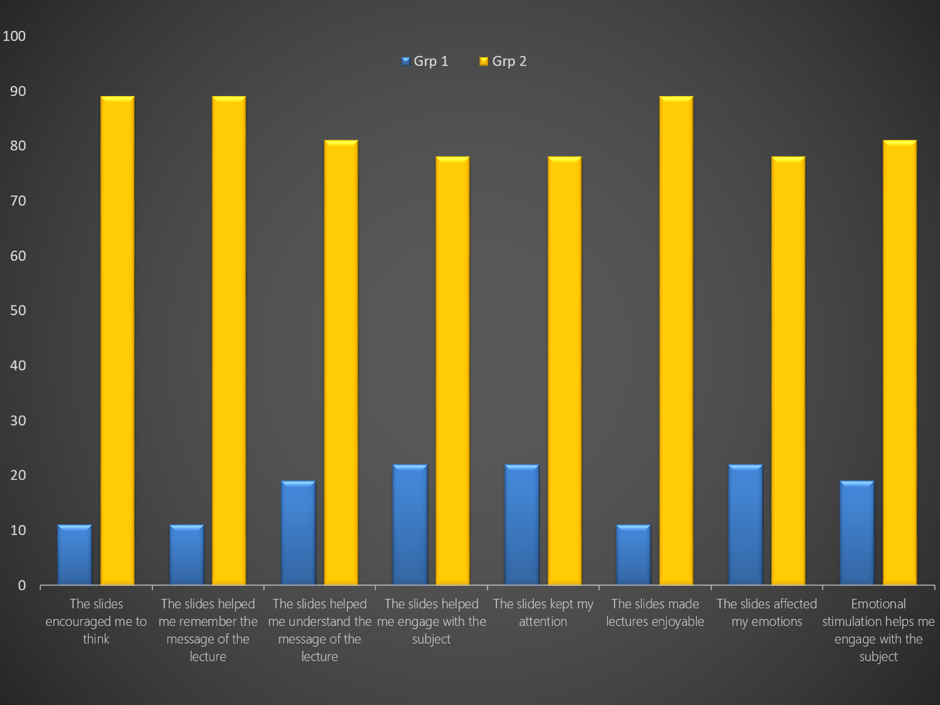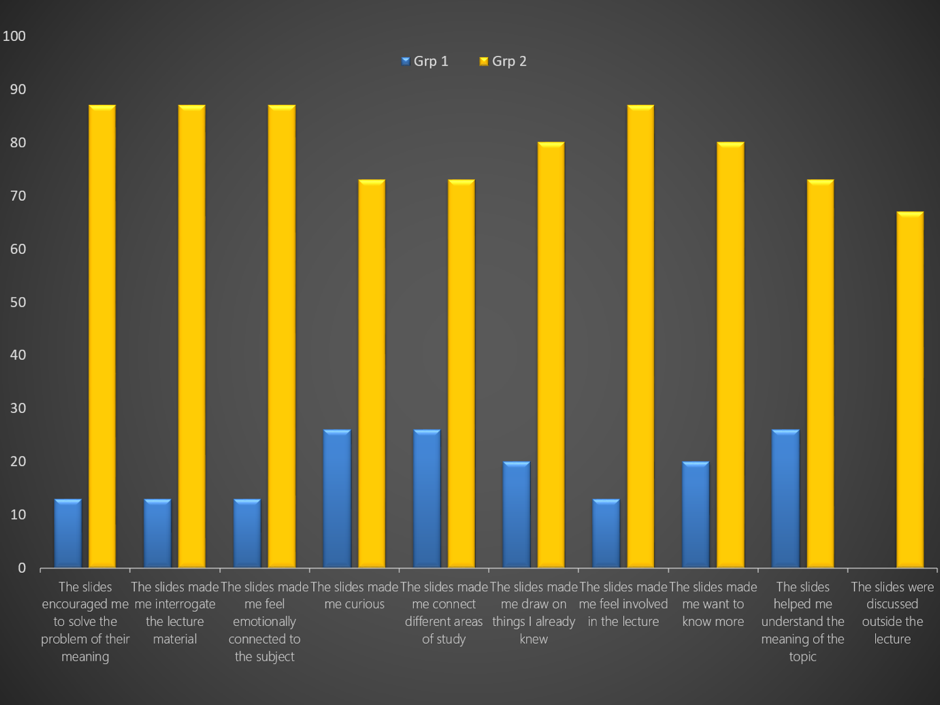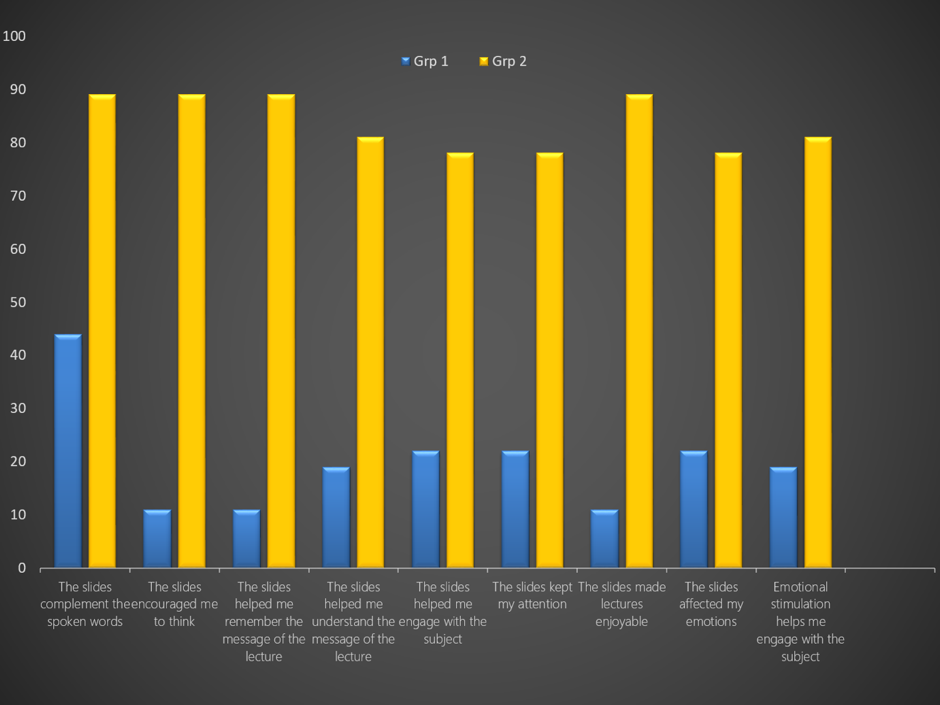
This article is concerned with the gap between how we teach International Relations and Politics (IR & P), and how students learn this subject at the physiological level. It discusses a 3-year trial of a visual pedagogy that better matches how we teach, to how our students live and learn. A visual pedagogy challenges the prevailing hegemony of text as the logocentric medium of the message, addressing how contemporary media are changing and how universities are too often out of touch with the lived digital visual realities of the world they are tasked with serving. The article offers a pedagogy fit for purpose in the visual, digital 21st Century. It begins with a discussion of the wider social and pedagogic context in which IR&P sits, and continues with a discussion of a visual form of pedagogy I have been developing, applying and testing in lecture settings. The article then offers empirical data from longitudinal student-led evaluations that demonstrate a substantial increase in student engagement and which affirm a substantial increase in the presence of active learning characteristics in large group lecture settings. It concludes that for IR&P teaching to properly reflect the new realities of the digital visual era, the discipline needs to understand better why imagery is important and how it helps us present and understand complex scholarly material. The concept has been the subject of HEA-sponsored Fellowship events, and has been the subject of several peer-reviewed presentations in BISA conferences.
Despite our teaching and career progression becoming increasingly subject to benchmarking against the UK Professional Standards Framework, relatively few colleagues research and publish on International Relations & Politics pedagogies (Lester, 2014; van der Sluis, et al., 2017). This has come to mean that we remain, all too often, rooted with the orthodox and dominant tendencies, especially concerning our primary large group delivery platform, PowerPoint (Lester, 2014; Adams, 2006; Barber, 2007; Coats, 2006). This does not imply the profession is content with this situation, but alternatives seem to be lacking for many (Adams, 2006; Barber, 2007; Coats, 2006).
Most people use Powerpoint to teach in lectures, most of the time, all over the world (Lester, 2014; Tufte, 2015). We tend to let the software itself frame how we present from the outset, when the cursor is blinking inside the placeholder, next to the bullet point where we start typing our content. Furthermore, we fill each slide with several bullet points, sentences and paragraphs of text. A review of the literature affirms this approach (Adams, 2006; Barber, 2007; Kernbach, et al., 2015; Mahin, 2004), and experience of academic lectures to students and at conferences over the last 25 years confirms this is the standard means of presenting. It is also the norm beyond the academy in the Private and Third Sectors (Thompson, 2003; Cuthbertson, et al., 2015; Kosslyn, 2007). PowerPoint has attracted global opprobrium, and has become ‘parodied, disparaged and blamed for failures to communicate clearly’ (2007, p. 77). Peter Norvig, Google’s then Director of Research, went as far as to suggest that PowerPoint was more dangerous than an AK47 assault rifle, because very bad things can be done with it (Jarvis, 2014, p. 165). Edward Tufte, Emeritus Professor at Yale University, famously quipped that ‘Power corrupts, and PowerPoint corrupts absolutely’ (2015). It has even been blamed in part for the Columbia shuttle disaster in 2003 (Thompson, 2003; Meira, et al., 2010). We may know the phenomenon as ‘Death by PowerPoint’.
Pedagogic Hegemony
PowerPoint has become a hegemonic pedagogic and instructional tool for the 21st Century, sanctioned and necessitated by neoliberal managerial priorities in processing the greatest number of students in a partly-privatized Higher Education system. It has been facilitated in this process by Microsoft’s ubiquitous techno-deterministic approach to conveying material to audiences. It is cost effective, whether or not it is a good teaching method. It involves and encourages, as one scholar put it, the laborious ‘shovelling’ of masses of information from academics to their students (Schrand, 2008) by means of a digital projection platform created originally to help professionalize presentations. This diverse digital platform is capable of many things, including projecting film, online video and sound, but we mostly persist in perpetuating the familiar textual hegemony common to the pre-digital era. Not everyone uses PowerPoint to project text exclusively in lectures. Sometimes, we will punctuate text and bullet points with audio-visual material but this is primarily as an appendage, not a parallel and vital medium for learning and understanding. Despite the potency of the digital era for communication, we tend to persist with an eccentric text-centricity that marginalizes visuality despite visuality’s present ascendancy being unparalleled in human history. It is a near-universal condition partly because Microsoft Office and PowerPoint enjoy global market domination and partly because the software itself discourages deviation from text.
That textual hegemony is mirrored in scholarly publications in IR&P. Journals, like lectures, privilege logocentric material, and if images are used at all, it is in a supporting role for the longstanding textual paradigm (Mitchell, 1994). In academia, broadly and in the teaching and study of IR&P more specifically, the role of imagery is primarily to ‘simply entertain or illustrate, providing a respite from serious academic work’ (2008, p. 23). A visual alternative to textual hegemony is routinely met with distrust or even hostility, and the discipline has proven reluctant to engage with the use of imagery in teaching and also in the publication of research on images. This is not the case with pedagogic journals, which have started to support the use of imagery in their publications. Such attitudes mean that the application of the visual in IR&P (and most other) teaching continues to be marginalized (2010, p. 44; Bleed, 2005), in a similar way that orthodoxy in IR resists innovation and challenge (Grayson, 2015; Roberts, 2010; Baxi, 1998).
The persistent practice of textual hegemony is harmfully at odds with several important elements of our students’ inner and outer worlds; and with emerging pedagogy that reasserts an ancient idiom we appear to have forgotten. In short, the prevailing pedagogy we privilege appears to do a disservice to our students’ potential learning and teaching experiences. This is the case at every university that teaches IR&P. everywhere, because most colleagues use PowerPoint to privilege text delivery, rather than use it to balance visual and textual teaching material.
Falling Walls and Rising Technologies
IR has been well-placed to observe and represent, if not predict, epoch-shifting phenomena that combine to create the altered reality our students know as ‘life’. The artifacts they take for granted like laptops, the web and digital camera phones arose from the juncture of geopolitically-unbridled technological development facilitating and facilitated by the reduction of barriers to global mobility. After 1989, the digital revolution merged with its political counterpart, producing for our student audiences the capacity to capture, transmit worldwide and then download digital representations of an increasingly-accessible world. Where once we snapped and waited a fortnight to see if our cameras had been pointed in the right direction, now globalization and digitization combine to host and distribute hundreds of millions of images to billions of souls (Mitchell, 2002; McStay, 2013; King, 2016). Facebook alone can absorb 300 million images a day (Cuthbertson, et al., 2015, p. 158).
Outer Worlds
As early as 1996, the Harvard Educational Review noted an imminent shift towards ‘multiliteracies’ that reflected the kind of transformations presently sweeping social, political and technological existence (Cazden, et al., 1996). That trend will increase as better and cheaper digital technology continues to breach underdeveloped and emerging markets and as these technologies improve and become more affordable. Indeed, students sometimes have a hard time understanding how previous generations have so relatively few photographs of their childhoods. Peter Felten refers us to the idea of the ‘pictorial turn’ (Felten, 2008, p. 60; Curtis, 2013) in human evolution. This denotes the notion that the flood of technologies able to capture images is matched by the capacity of technologies to distribute them to an unparalleled degree. Such diversification is matched by the expansion of forums for the editing, production and dissemination of amateur and professional moving images; there has never before been such a range of material to watch on TV. It is not to suggest people don’t read. It is to argue that people have never had more imagery to look at, and visual processing is a central means for our understanding of the world (Huxley, 1982; Mayer, 2014; McStay, 2013).
There has never been a more visual time for human beings (Goldfarb, 2002; Beetham & Sharpe, 2013), and we are well-equipped to understand the world around us visually This is the era in which visual media have become ‘the main means of communication and expression in postmodern culture’ (Tietje & Cresap, 2005). This visual environment helps shape our students’ lives and expectations long before they arrive with us, leading Coats to argue that universities face ‘the most visual of all learning cohorts’ (2006, p. 126).
However, our students’ external worlds are quite at odds with what happens when they come to study. Upon arrival at university a recognition of the increasing visuality of the media, of communication and of the idea of visuality in teaching in schools is not always the experience they receive. Until our students get to tertiary education, their learning experiences have combined the textual and the visual, from the first moments they see pop-up books, video and TV on demand, playschool and through to post-16 education. But unless they have chosen a particularly visual subject like Art and Design or graphic communication, their experience will switch from a balance of textual and visual media, to one that is almost exclusively textual; this is normally the case with IR & P. The primary medium through which students are taught is textual. Where static and moving imagery appears, it is not considered a medium in itself for the communication of knowledge, ideas and learning, but as an appendage to hegemonic textual preferences historically associated with the study of Social Sciences.
Inner Worlds
Those text-centric experiences do not match the visual era Felten and others (above) note. But in addition, textual predominance is at odds with the way our students’ brains work. Multimedia Learning (MML) scholarship tells us that we learn better with images and text than with text alone because sighted people are dual processors of information (Mayer, 2014; Mayer & Sims, 1994). The short version (drawn from half a century of peer-reviewed research and publication on cognition and memory) is that we can receive information through two channels (Paivio, 1971; Paivio, 2014; Lewis, 2016; Ayres, 2015). One channel covers audio-textual information and the other covers visual. Sighted people are set up to engage and understand the world through both our ears and eyes, and to this extent, we are all visual learners. It is not the case, according to MML research, that a given percentage of the population learns visually. We all do (Mayer & Moreno, 1998; Paivio, 2014; Sorden, 2013). If we didn’t, we wouldn’t be reliably successful at crossing roads or any other such act that required us to see what was around us, process that information and make choices about what to do with it.
MML further argues that using text alone predominantly overloads our ability to process the text we are receiving (Lewis, 2016; Mayer & Moreno, 2003; Sweller & Chandler, 1991). In this sense, using text and not using images is a double-edged sword. It overloads the channel through which we attempt to process masses of text whilst leaving unused our visual processing channel, reducing the potential learning experience (Ayres, 2015; Beetham & Sharpe, 2013; Paivio, 1971; Sorden, 2013). It may be likened to a 4-cylinder car engine running on only two cylinders. The two that are working are overloaded and cannot properly propel the weight of the car. The two that aren’t working are wasted potential (not using visuals). The message from MML is clear: images and text are better for learning and understanding than text alone – an apposite image is worth a thousand words.
MML is not alone in terms of inquiry concerning images as a legitimate and effective medium for communication. International Relations scholars have not been asleep in this debate – although ‘pedagogy’ appears in only 2 titles found during a search of the E-IR database in March 2017. In the same year that Felten proposed a pictorial turn, Cynthia Weber advanced the use of ‘still, moving, and multiplying media (photography, film, web-based windows)’ (2008, p. 138). Jack Holland notes that university staff presently use TV ‘clips, episodes and even entire series as part of their modules and programs’ (2016, p. 173). Holland used ‘The West Wing’; Deylami and Havercroft edited a book on the US miniseries ‘The Wire’ (2017). Safia Swimelar uses mainly film to support teaching on human rights (2013), as have others like Simpson and Kaussler (2009) and Kuzma and Haney (2001). This work, and the research of Brandon Valeriano (2013), also concerned with film, stands alone as inquiry into effectiveness in given IR&P modules; but it is not contextualised in higher pedagogic theory that critiques the idea of visual imagery as a legitimate medium in its own right for the communication of complex matters. To paraphrase Marshall McLuhan (1964), the message is the medium.
This article is concerned with considering the viability of imagery as a viable pedagogic communication medium in itself that is as important as text in some respects, especially when it comes to enhancing student intellectual engagement, and to stimulating active learning in large group settings. ‘Death by PowerPoint’ is not in our imagination. The following section of this article reviews a 3-year experiment undertaken with IR&P students at a UK university. The visual method discussed here was the subject of a TEDx talk and a consultancy developed with the support of Loughborough university. David Roberts has been using high quality, full-slide images in conjunction with reduced visible text (original text can be moved to the ‘notes view’ area of PowerPoint) in all lectures for all modules he teaches on an International Relations undergraduate degree at Loughborough University. Images can be any format (paintings, photographs, graphic art, Photoshop creations, creative design) and were all stills. They divide into representative or literal images that effectively described a given subject, and figurative or metaphorical images that conveyed the unfamiliar through familiar frames of visual reference.
From the student base, volunteers were sought over three years for randomized control trials each semester following the usual scientifically-respected protocols (Concato, et al., 2000; Fives, et al., 2015). Two groups of 10-15 were used each time. The first of these two groups attended a 10-minute presentation on a matter of Politics and IR delivered using text and bullet points. The second group received the same information expressed with text and images. Each group completed an online survey immediately after the experiment.
The quantitative results are published in detail in forthcoming journals but an abridged version appears below. The research questions concerned student intellectual engagement with academic material in lectures as per Gibbs (Gibbs, 2014) and Trowler (Trowler, 2010) , and the presence or absence of key characteristics of active learning, selected from the established scholarship on the subject (Prince, 2004; Haidet, et al., 2004; Wolff, et al., 2015). The experiment also considered impact specifically on dyslexic students, by request of some dyslexic students’ exposed to the teaching method in the course of two semesters. The results of the controlled trials appear below. The placebo group exposed to standard methods is marked in blue. The experiment group is yellow.

Table 1: Comparative engagement 2014-2016
This pattern was consistent in each year, with students at each level, with no significant variation between males and females or across ages.

Table 2: Comparative active learning 2014-2016
The process prompted by the images was described by one group of students as ‘auto-interrogative’ after some lengthy discussion with the moderator. They couldn’t prevent themselves from trying to establish the meaning of the images and were, often, not even aware they were engaged in such a process.

Table 3: Comparative dyslexic student engagement 2016
Dyslexic students’ reactions mirrored those of neurostandard students. It is widely acknowledged that many (not all) students experiencing dyslexia find text challenging generally (von Karolyi & Winner, 2004; Schneps, et al., 2007; Coppin, 2009) at a higher level than neurostandard students. But both groups experience text overload which can be relieved by balancing text and images more evenly.
Conclusion
In International Relations and Politics, we devote ourselves to considering how globalization, technological transformation and social evolution impact the subject material we research. But we spend relatively little time considering how these forces affect how we teach. Given the undeniably visual range and scope of the digital world, the ways the subject matter of PIR lend themselves to visual reproduction and dissemination, and the extent to which our students’ worlds are conveyed to them visually, then to paraphrase Grayson, it would seem ‘amiss to omit it from the teaching of international relations’ (2015, p. 161). There are, quite literally, billions of images accessible as more people join key image-sharing sites like Facebook, with expanding visual representation of world events and the means to capture and project them. MML scholarship, itself based on decades of respected and recognized research into cognition and memory, tells us that hegemonic pedagogic practices in IR teaching are at odds with the capacity of our brains to interpret and make sense of the world visually. The outcome of empirical testing in line with respected methodological approaches with IR&P undergraduates of an easy-to-develop visual teaching practice corroborates the predictions of MML theories concerning the potential for visual learning pedagogies to transform passive didactic lecturing spaces into engaged spaces of active interrogation and learning. The visual opportunities facing the discipline’s pedagogy in the ultra-visual 21st century should be openly engaged with, rather than shunned for appearing to be unorthodox.
Further Reading on E-International Relations
- Enhancing Creativity and Communication Skills Through IR Signature Pedagogies
- New Book – Signature Pedagogies in International Relations
- What to Do When You Don’t Like a Topic You Teach?
- Working with and Supporting Teaching Assistants
- Black Lives Matter, Poetry, and Pedagogy: On Gil Scott-Heron and Global Protests
- Marks That Matter: Slow Letters to Authors and Selves